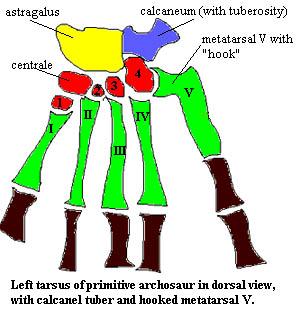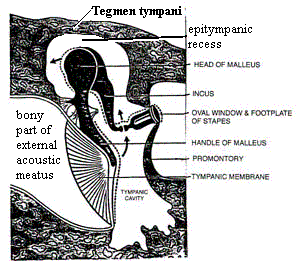| Glossary | ||
| The Vertebrates | Ta - Th |
| Vertebrates Home | Vertebrate | Vertebrate | Bones | Time |
For most phrases beginning with directional words, e.g. "posterior," "dorsal," "external," etc., or some generic anatomical terms, e.g., "vena," look under the next word in the phrase. However, note that this convention is not used with complete consistency in this Glossary.

Tabular horn a posterior or posterolateral projection of the skull table formed by the tabular and/or squamosal in basal tetrapods, particularly embolomeres.
Taenia clino-orbitalis an ossified pila antotica.
Taenia marginalis a cartilage which runs sagitally along the midline of the skull table, just under the dermal bones.
Talon in mammalian dentition, the distolingual (toward the tongue & back of the mouth) extension of an upper molar, as opposed to the main, triangular part which is the trigon. The main cusp on the talon is the hypocone.
Talus the astragalus, one of the proximal tarsals (ankle bones). Primitively, it links the tibia with the distal tarsals, particularly the navicular. The term talus is primarily found in medical sources. Another synonym, tibiale, is used for Paleozoic tetrapods and sometimes elsewhere. The great English composer, Thomas Tallis (1505 - 1585), spelled his name quite differently. If you are a Tallis Scholar (or one of their fans) who has happened on this web site, your musical tastes are excellent, but you need to improve your spelling skills.
Tapetum lucidum the reflective layer of the retina that causes the eyes of, e.g., cats to appear to shine in darkness. An adaptation for nocturnal vision.
Taphonomic relating to burial, decay and fossilization. A taphonomic artifact is an artifact caused by these processes. A classic example is the sharply arched neck of some long-necked dinosaur fossils. After death, the tendons of the back and neck dry out. In life these tendons are formed by collagen, elastin, and other fibers which are held in a springy, elongated conformation through hydrogen bonds and other polar interactions with water. When the tendons dry, the fibers assume a more compact conformation and the neck is retracted back over the body slowly, but with great force.

Taphonomy study of the processes of decay, burial and fossilization.
Tarsal (bones) Series of bones in the ankle. The astragalus, calcaneum, and distal tarsals. They are distal to the fibula and tibia and proximal to the metatarsals
Tarsometatarsus in birds, the fused unit comprising the tarsus and metatarsus (ankle and foot).
Tartarian the last age of the Permian, 252-248 Mya.
Tecopa Lake A Plio-Pleistocene lake located in the present Death Valley, California important for good preservation of upland species and well-constrained chronology. Whistler & Webb (2005).
Tectal one or more anterolateral dermal skull bones in fishes. The posterior tectal is homologous to the tetrapod prefrontal. Vorobyeva & Schultze (1991). The anterior tectal lies just above the nares and may be homologous to the tetrapod septomaxilla. A pretty, but crowded, image may be seen here.
Tectorial membrane a membrane in the mammalian cochlea. Part of the Organ of Corti. See the Ear.
Tectum a roof-like structure, particularly the dorsal part of the midbrain.

Tegmen tympani thin plate of bone forming the roof of the epitympanic recess in the middle ear. Also referred to as the anterior process of the petrosal. Luo 1998).
Telychian the third and last stage of the Llandovery Early Silurian). The beginning of the Telychian has not been determined. It ended 428 Mya.
Temno- Greek root for cutting.
Temporal bar Not to be confused with Callahan's Crosstime Saloon. Most amniotes have at least one hole in the skull behind the eyes which probably evolved to allow more room for the jaw adductor muscles, i.e. the temporal fenestra(e). The lower margin of these holes is formed by a bar of bone, the temporal bar. The term is most often used in reference to synapsids (e.g., mammals). Synapsids have only one temporal fenestra, so that the term is unambiguous. The temporal bar is formed by some combination of the maxilla, jugal, squamosal and quadratojugal. The exact makeup of the temporal bar is important because it is frequently diagnostic of the group.
Temporal condyle a medical misnomer for the temporomandibular joint. Its a misnomer because a condyle is a rounded projection with an articular surface. With respect to mammals, the condyle is on the dentary and is properly referred to as the dentary condyle. This condyle articulates with the glenoid fossa on the squamosal or, to use medical terminology, on the squamous portion of the temporal bone.
Temporal fenestra Most amniotes have at least one hole in the skull behind the eyes which probably evolved to allow more room for the jaw muscles. Generally, mammals have one temporal fenestra, while sensible animals have two. See examples and full explanation at Temporal Fenestration and the Classification of Amniotes.
Temporalis muscle of mammals, a muscle which originates broadly in the temporal fenestra and normally attaches on the medial or anterior face of the coronoid process. It elevates and may retract the lower jaw. The m. temporalis is innervated by the Vth cranial nerve. Extensive discussion and diagrams at The Mammalian Masticatory Apparatus. On the evolution of the temporalis, see the discussion at masseter.
Temporomandibular joint the dentary-squamosal jaw joint of mammaliforms; in particular the condition of living mammals in which (a) it is the only jaw joint and (b) only the squamosal temporal) and dentary participate.
Tenaculum a structure rather similar to a mixypterygial clasper, but developing anteriorly from the pelvis, found in certain Holocephali.
Tensor tympani a small muscle which inserts on the manubrium of the ear. Contraction of the tensor tightens the tympanic membrane and attenuates sound.
Tergal relating to the back, from. L. tergum = back.
Tergal angle the peak on the dorsal thoracic armor of some antiarch placoderms formed by the intersection of the median dorsal ridge with the ridges running from the outside corners of the anterior median dorsal plate.
Terrigenous having a terrestrial, as opposed to marine, origin.
Tessellate tiled; shapes which fit together in a repeating pattern. MC Escher is famous for his tessellations. In paleontology, the "repeating pattern" part is frequently ignored and any surface made up of small, congruent polygonal pieces is said to be tessellate.
Thagomizer this started out as a Far Side joke, but has now more or less become a part of the serious anatomical literature. The thagomizer is the, otherwise difficult to describe, collection of spikes at the end of a stegosaurid's tail. It is named after the late Thag ...
Thanatocoenosis death assemblage, more or less. A true death assemblage represents a collection of organisms which all died in a "common accident" as they say in the insurance business. A thanatocoenosis is a dodgier sort of word -- the sort of word where one really wants a bunch of Greek roots to disguise a squishy lack of precision. It refers to a bunch of different organisms which all lived and died at about the same time and in about the same place, give or take a few miles and a hundred thousand years. The implication is not that these particular individuals were next-door neighbors, but that their actual next-door neighbors included members of those species found together as fossils.
Thecodont See Tooth Implantation. Having teeth set in sockets, without ankylosis to the jaw (as a noun, thecodonty). Archosauria: More on Morphology.
Thoracic Relating to the thorax, i.e. the chest or upper (anterior) body.
Thyroid fenestra fenestrated pelvic girdle, a broad opening between the pubis and ischium (characteristic of Lepidosauria).